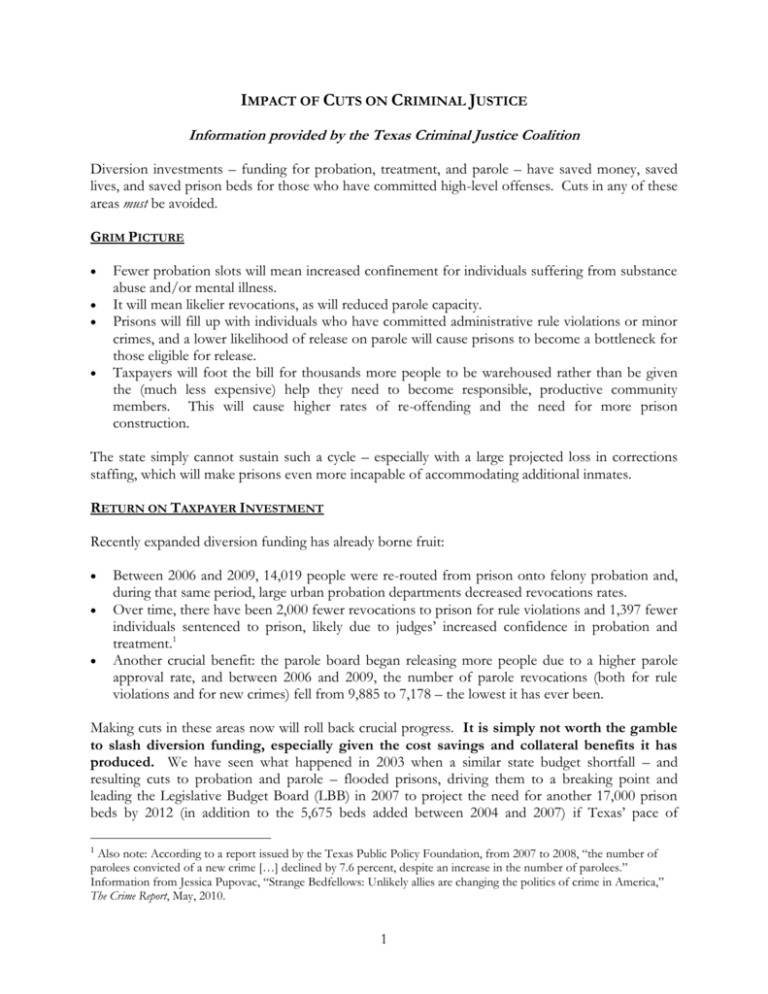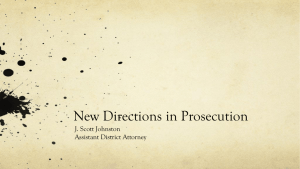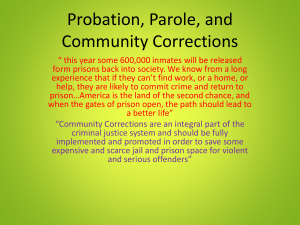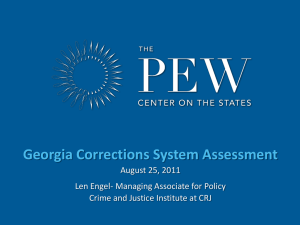Diversion investments – funding for probation
advertisement

IMPACT OF CUTS ON CRIMINAL JUSTICE Information provided by the Texas Criminal Justice Coalition Diversion investments – funding for probation, treatment, and parole – have saved money, saved lives, and saved prison beds for those who have committed high-level offenses. Cuts in any of these areas must be avoided. GRIM PICTURE Fewer probation slots will mean increased confinement for individuals suffering from substance abuse and/or mental illness. It will mean likelier revocations, as will reduced parole capacity. Prisons will fill up with individuals who have committed administrative rule violations or minor crimes, and a lower likelihood of release on parole will cause prisons to become a bottleneck for those eligible for release. Taxpayers will foot the bill for thousands more people to be warehoused rather than be given the (much less expensive) help they need to become responsible, productive community members. This will cause higher rates of re-offending and the need for more prison construction. The state simply cannot sustain such a cycle – especially with a large projected loss in corrections staffing, which will make prisons even more incapable of accommodating additional inmates. RETURN ON TAXPAYER INVESTMENT Recently expanded diversion funding has already borne fruit: Between 2006 and 2009, 14,019 people were re-routed from prison onto felony probation and, during that same period, large urban probation departments decreased revocations rates. Over time, there have been 2,000 fewer revocations to prison for rule violations and 1,397 fewer individuals sentenced to prison, likely due to judges’ increased confidence in probation and treatment.1 Another crucial benefit: the parole board began releasing more people due to a higher parole approval rate, and between 2006 and 2009, the number of parole revocations (both for rule violations and for new crimes) fell from 9,885 to 7,178 – the lowest it has ever been. Making cuts in these areas now will roll back crucial progress. It is simply not worth the gamble to slash diversion funding, especially given the cost savings and collateral benefits it has produced. We have seen what happened in 2003 when a similar state budget shortfall – and resulting cuts to probation and parole – flooded prisons, driving them to a breaking point and leading the Legislative Budget Board (LBB) in 2007 to project the need for another 17,000 prison beds by 2012 (in addition to the 5,675 beds added between 2004 and 2007) if Texas’ pace of Also note: According to a report issued by the Texas Public Policy Foundation, from 2007 to 2008, “the number of parolees convicted of a new crime […] declined by 7.6 percent, despite an increase in the number of parolees.” Information from Jessica Pupovac, “Strange Bedfellows: Unlikely allies are changing the politics of crime in America,” The Crime Report, May, 2010. 1 1 incarceration continued. The price tag: $1.3 billion.2 Since then, wise investments in key diversions have safely reduced incarceration levels and have gotten the state back on track. As of June 2010, the LBB projected that incarceration levels will remain flat, while felony probation levels and parole levels will steadily increase – provided current, cost-effective alternative-toincarceration policies, as well as probation, parole, and treatment expenditures, remain in place. HARMFUL IMPACT OF PROJECTED BUDGET CUTS Cuts to diversion strategies will have enormous fiscal and public safety ramifications: If all diversion funding added to probation and parole in 2007 and 2009 as well as all past diversion funding appropriated to probation were eliminated, it would cost the State $303,196,210 in FY 2012/2013. In FY 2014/15, the State will have to spend $213,443,322 to construct and operate three new prisons. In FY 2016/17, the State will have to spend $426,886,664 to construct and operate six new prisons. In FY 2018/2019, the State will have to spend $853,773,328 to construct and operate twelve new prisons. Why risk a devastating step in the wrong direction? CONCLUSION Programs and services that exist solely to rehabilitate individuals and reduce their risk of recidivism must be preserved. Probation must continue to be a strong, viable alternative to prison, while parole departments should be provided more tools to assist those under supervision. Texas needs continued investments in the fidelity and success of diversions today to help meet public safety demands and create safer communities tomorrow. The state simply cannot afford to have costly incarceration be its only option for addressing criminal behavior. Jessica Pupovac, “Strange Bedfellows: Unlikely allies are changing the politics of crime in America,” The Crime Report, May, 2010. 2 2











